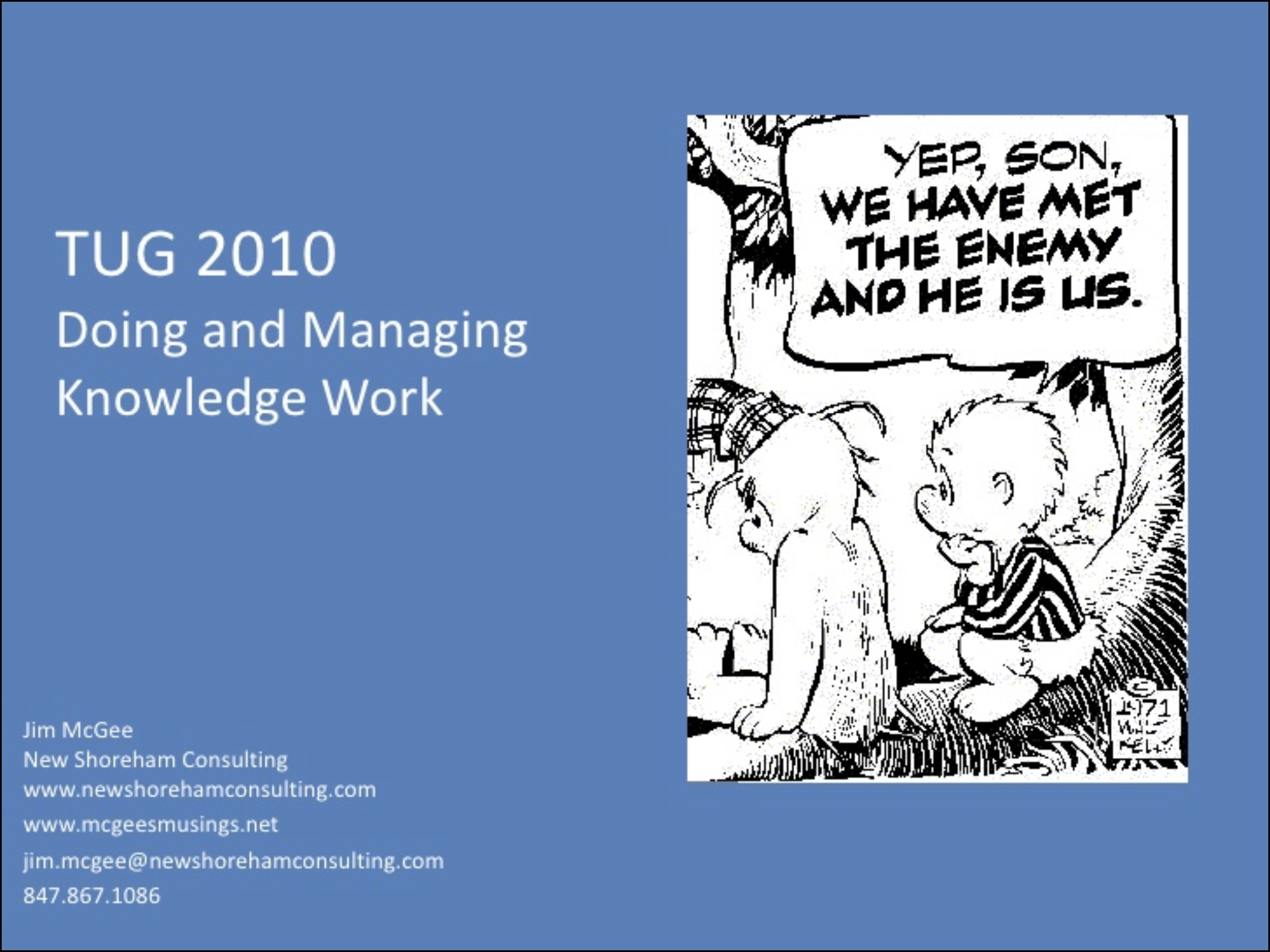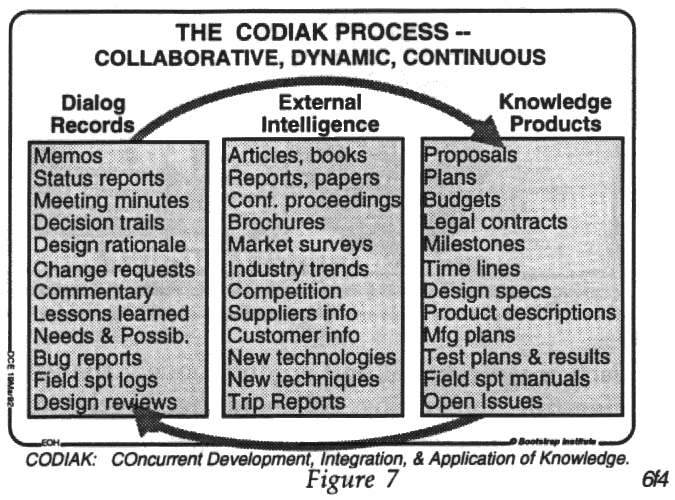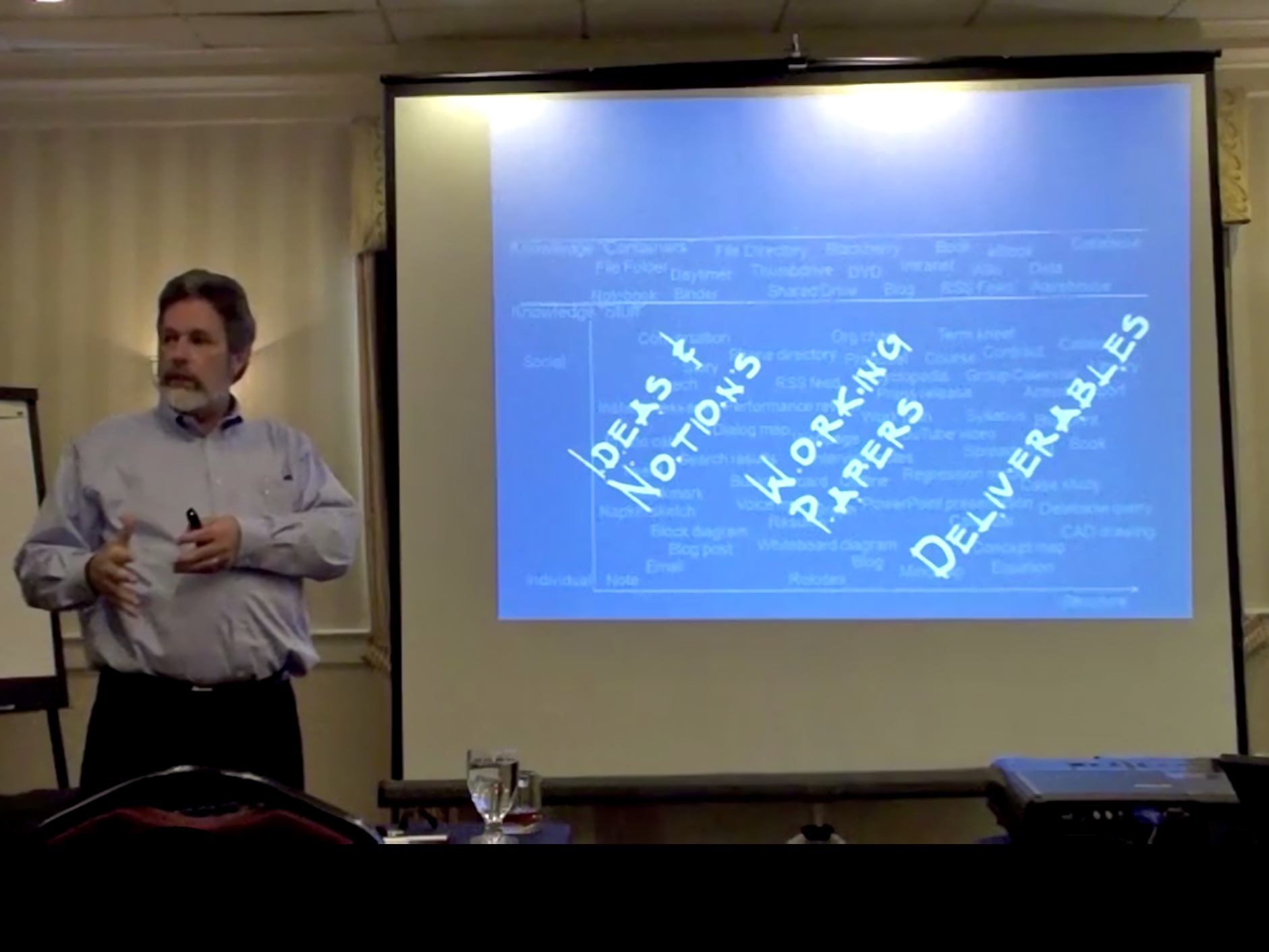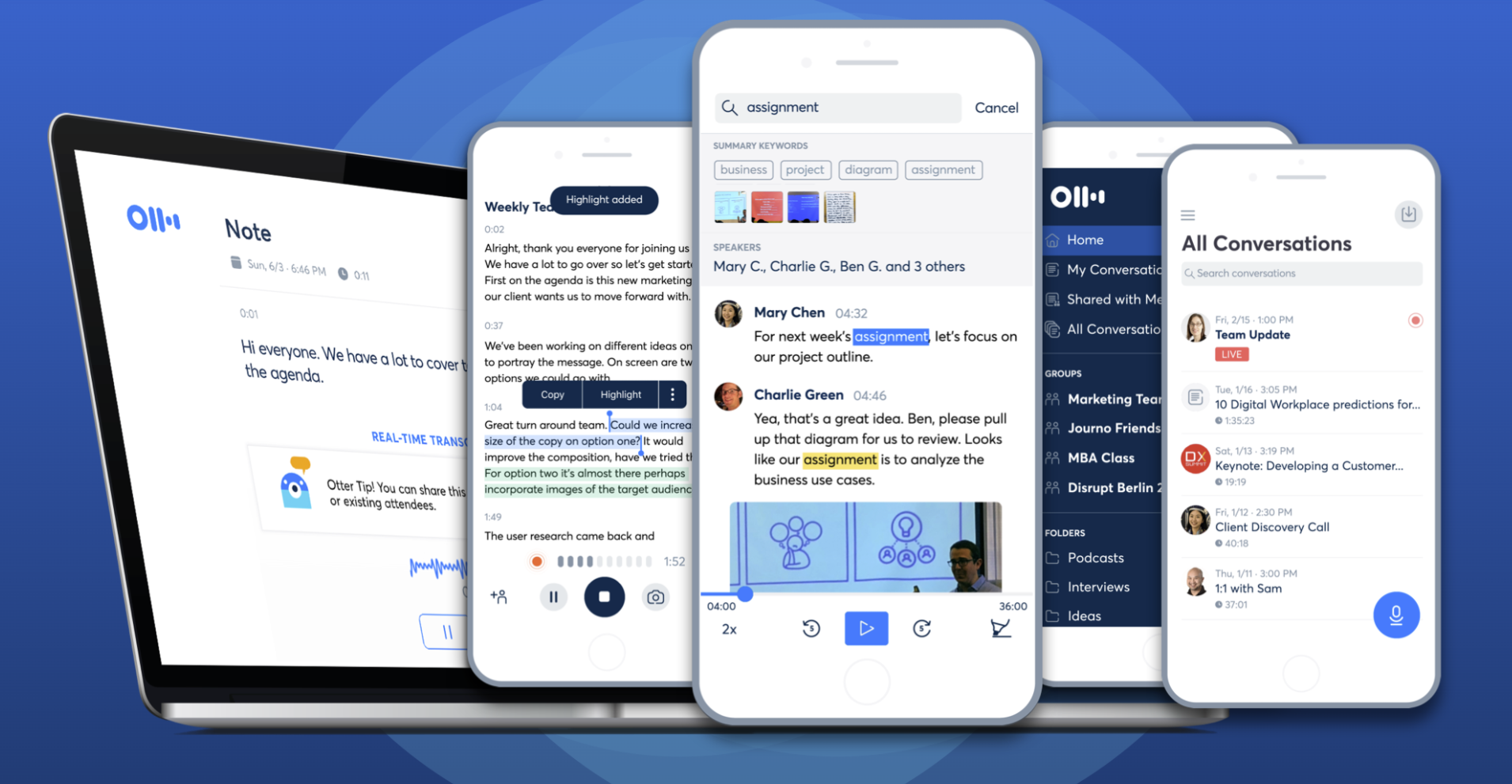More Observable Work - Transcribing Jim McGee's TUG 2010 Keynote
 Working from home like much of the world, I thought it would be a good time to try out a new tool to transcribe Jim McGee's Doing and Managing Knowledge Work TUG 2010 keynote. The 2010 Traction User Group theme was Observable Work, with Jim's opening keynote, a closing keynote by Jon Udell, and a four hour Observable Workshop moderated by Jon on the last morning of the meeting, see 12-15 Oct 2010 | Fifth Annual Traction User Group Meeting, TUG 2010 Newport
Working from home like much of the world, I thought it would be a good time to try out a new tool to transcribe Jim McGee's Doing and Managing Knowledge Work TUG 2010 keynote. The 2010 Traction User Group theme was Observable Work, with Jim's opening keynote, a closing keynote by Jon Udell, and a four hour Observable Workshop moderated by Jon on the last morning of the meeting, see 12-15 Oct 2010 | Fifth Annual Traction User Group Meeting, TUG 2010 Newport
Jim and Jon spun out the value of 'observable work' in blog posts from 2002 through 2010. In 2002, Jim wrote:
"One thing that differentiates knowledge work today from other craft work is that, except for final product, knowledge work is essentially invisible. All the important stuff takes place inside knowledge workers's heads. This has not always been true of knowledge work and need not be true.
. . One unintended consequence of today's technology environment is to make the process of knowledge work less visible just when we need it to be more so. The end products of knowledge work are already highly refined abstractions; a financial analysis, project plan, consulting report, or article. Today, the evolution from germ of an idea through intermediate representations and false starts to finished product exists, if at all, as a series of morphing digital representations and ephemeral feedback interactions."
In 2010 Jon wrote:
"In the pre-industrial era, education and work were: Observable, connected
In the post-industrial era, they are: Non-observable, disconnected"
I don’t think the notion of visible work or observable work is new: mentoring, apprenticeship, and letting trusted folk watch, learn and use what they see on their own is how law, medicine and other professions were originally taught and refined as collaborative practices - and it's still so today. But as Jim points out, we've lost some of the habits of observable work - to some degree intentionally, to some degree due to blinders added by the tools we've grown comfortable using.
I believe that principles of open, observable work – like open book financial reporting to employees – is a simple and powerful principle that people at every level of an organization can become comfortable using. In my opinion, wider adoption of observable work principles can succeed with support and encouragement from true leaders at every level of an organization, as Peter Drucker defines that role: "A manager's task is to make the strengths of people effective and their weakness irrelevant—and that applies fully as much to the manager's boss as it applies to the manager's subordinates."
Jim's opening keynote set the stage
Jim McGee 18:14
I had an insight many years ago when I was trying to understand why it was that we weren't seeing take up of the system, the knowledge management systems we were deploying. What was, why weren't we getting knowledge sharing? Why wasn't it happening? And what I realized in the shower one morning, where all best ideas occur, I got it. I knew who the lazy SOB was, wasn't doing the share. It was me six months ago.Jim McGee 18:49
I wasn't sharing with myself. I wasn't paying attention to what I needed to do when I did it. And so I couldn't I couldn't find my own work. And I can't find In my own work and on the other knowledge workers in your organization can't find their own work.Jim McGee 19:27
And the sharing takes places, the sharing if you look at the social dimension of knowledge sharing in most organizations, it all starts with a conversation or a phone call. You never find anything useful going directly into the knowledge management system. Never. You always find something useful talking to someone who will point you to - and we keep thinking of that as a bug, not a feature.Jim McGee 19:59
But that's really the only way it's going to work.
Jim used a two dimensional diagram to show artifacts of work, with individual to socially constructed artifacts shown vertically, and informal to formally structured artifacts shown on the horizontal axis. In broad categories he talked about 'Ideas and Notions' on the left, 'Working Papers' in the center, and 'Deliverables' on the right.
Jim McGee 31:13
So if you get if you get too focused on deliverables you lose sight of what sort of what comes after the deliverable, which is the decision or the action. So, but you start with deliverables and you start making you start tracking and you keep you pay attention.Jim McGee 31:28
But the next piece is then you move back to a concept that I learned back in my days when I had to work in an auditing firm. I was a consultant, but it was it was Arthur Andersen and they wanted all of us to pretend that we knew something about auditing. I actually had to go into a vault once and literally count stock certificates and bond certificates as part of an audit.Jim McGee 32:05
But one of the brilliant things that auditors did is they created this notion of working papers. They were all paper that but you know all of the documents and memos in the in the intermediate products that they worked with along the way to get to the.. . Cause the deliverable for an auditor was it was a two page letter. Right? Jim McGee 32:27
And in fact, 90% of that two page letter was strict boilerplate. So what they needed to do in order to justify it to themselves and to their clients, but they needed to, they needed to be able to demonstrate what work had gone into creating a deliverable. We reviewed this many accounts, we sent these letters out to, you know, shareholders, we did X we did Y we ran this analysis, we found that and so this notion of working papers is a useful one to recover and to think in terms of as you do the work work you're doing is to think in terms of the intermediate products because the intermediate products are the ones where real reuse is going to be possible.. . Jim McGee 33:42
Okay, now I got to source the data differently, but the analytic piece still holds. Now if it's buried in a deliverable I can't I can't find it. So you know, I can I you know, what, what you'll do if you're if your knowledge system is only working with deliverables is you go in, you open up a bunch of deliverables and you skim through it, you look for the graph, and then you try, then you hope you can find the particular analyst who did the work.Jim McGee 34:10
Because, you know, damn well the partner doesn't understand what went into the analysis and track that individual down and say, you know, Mary, what, how was it that you did that? Right? And what was the creative? So, you know, I think the next piece of this, you know, to attack is going after work again, creating those intermediate objects and making those visible with tags, nothing, nothing exotic.
Jim McGee 34:39
You just, you want to be able to find them when you need them. And give a little bit of thought to that. And eventually, you know, I think we're gonna get back to capturing scraps of ideas and notions and whatnot. I saw over there. I Oh, and I always have paper on, you know, little notebook in my pocket, just because you I'm old enough, if I don't capture it, if that idea comes, it's going in a hurry. If I don't get it as it goes by, it's never coming back.Jim McGee 35:15
And so you do those and then and then the other thing that I've learned with you that you then have to write it down a second time. If to take a little note and you have to read the note and reconstruct what you were thinking when you wrote the note. Right? And if you do that within 24 hours that usually works. If you wait 48 hours, it's -- I can't actually I can't read my handwriting after about 72 hours.
Traditional notes and working papers have been limited to textual documents or playable media files. The content of live conversations and meetings have either been lost, or locked in a playable audio or video file that's easy to listen to or watch again, but difficult to skim quickly, search, or quote. Transcription of personal dictation or meetings has long been expensive and time consuming. With the advent of affordable machine learning technology, automated transcription has become cheap (starting at free), easy, and a new part of the fabric of online life and work. Now a lot of the conversations in the course of work become more observable and useable. I decided to experiment with Otter.
Otter.ai and Observable Work
Otter.
I ran across Otter.ai on Twitter based on it's review in TechRadar's Best speech to text software in 2020: Free, paid and online voice recognition apps and services:
Otter is a cloud-based speech to text program especially aimed for mobile use, such as on a laptop or smartphone. The app provides real-time transcription, allowing you to search, edit, play, and organize as required.
Otter is marketed as an app specifically for meetings, interviews, and lectures, to make it easier to take rich notes. However, it is also built to work with collaboration between teams, and different speakers are assigned different speaker IDs to make it easier to understand transcriptions.
There are three different payment plans, with the basic one being free to use and aside from the features mentioned above also includes keyword summaries and a wordcloud to make it easier to find specific topic mentions. You can also organize and share, import audio and video for transcription, and provides 600 minutes of free service. [per month]
The Premium plan comes in at $8.
33 per month when paid annually, and on top of existing features also includes advanced and bulk export options, the ability to sync audio from Dropbox, additional playback speeds including the ability to skip silent pauses. The Premium plan also allows for up to 6,000 minutes of speech to text. [per month] The Teams plan comes in at $12.
50 per user for a minimum of three users, and also adds two-factor authentication, user management and centralized billing, as well as user statistics, voiceprints, and live captioning.
I experimented several alternatives, including the Otter.
Otter.
Otter.
Cloud based speech to text software has become a lively market, but based on its charm as a personal note taking App that spans all of my Apple devices - including Siri and my Apple watch - and its utility when importing audio or video files for transcription, Otter.
Jim McGee TUG 2010 Keynote transcript
Jim McGee TUG 2010 Keynote video
See also
Related
Enterprise 2.0 and Observable Work
I really like Jim McGee's Jun 23, 2010 blog post Managing the visibility of knowledge work. Jim makes the excellent point that "Invisibility is an accidental and little-recognized characteristic of digital knowledge work." and points back to his 2002 post Knowledge Work as Craft Work to reflect on what Jim calls a "dangerous tension between industrial frameworks and knowledge work as craft work". Early in his 2002 post McGee says:
"The Importance of visibility in craft work Almost by definition, the final product, process, and intermediate stages of craft work are visible. Consider your experiences at a glass blowing workshop or touring a silversmith's workshop. The journey from apprentice to master craftsman depends on the visibility of all aspects of craft work."
Jim continues with an exceptional analysis of what he calls "Knowledge work today as invisible craft"
"One unintended consequence of today's technology environment is to make the process of knowledge work less visible just when we need it to be more so. The end products of knowledge work are already highly refined abstractions; a financial analysis, project plan, consulting report, or article. Today, the evolution from germ of an idea through intermediate representations and false starts to finished product exists, if at all, as a series of morphing digital representations and ephemeral feedback interactions." See blog post
Two connections sprang to mind (and I didn't need a hyperlink to divert my attention - mea culpa):
1) Jon Udell's April 2009 talk at the April 2009 Open Education Conference. Udell says:
"In the pre-industrial era, education and work were: Observable, connected
In the post-industrial era, they are: Non-observable, disconnected"
Jon notes that only recently have work processes become network observable, and that this was rare in practice for all but software people. Jon speculates that software folk's norms of feedback, iterative refinement and testable outcomes seem aligned with principles of observable work - and they've become comfortable with networked technology after using the Internet for collaborative development of software and standards over many years.
2) Thomas Stewart in his book The Wealth of Knowledge (and my personal experience working on projects at the Naval Research Laboratory many years ago).
"A whale ship was my Yale College and my Harvard," said Herman Melville's Ishmael; when it came to learning my job, circulating correspondence was mine. Reading my superiors' letters opened a window into how they conducted business with the world outside; I aped things more experienced colleagues did, and saw how they handled tricky situations; I copied useful addresses into my Rolodex (another antique). I learned who knew what, and that made me better at asking for advice."
I don’t think the notion of visible work or observable work is new: mentoring, apprenticeship, and letting trusted folk watch, learn and use what they see on their own is how law, medicine and other professions were originally taught and refined as collaborative practices - and it's still so today. But as Jim McGee points out, we've lost some of the habits of observable work - to some degree intentionally, to some degree due to blinders added by the tools we've grown comfortable using:
"With e-mail, word processors, spreadsheets, and presentation tools, maintaining visibility of your knowledge work (at both the individual and workgroup level) requires mindful effort. An office full of papers and books provided clues about the knowledge work process; a laptop offers few such clues. A file directory listing is pretty thin in terms of useful knowledge sharing content. In an analog process, it’s easy to discern the history and flow of work. When an executive takes a set of paper slides and rearranges them on a conference room floor, a hidden and compelling story line may be revealed. You can see, and learn from, this fresh point of experience. That’s lost when the same process occurs at a laptop keyboard at 35,000 feet. The gain in personal productivity occurs at the expense of organizational learning."
I believe that Enterprise 2.
Enterprise 2.0 and Observable Work: Brian Tullis and Joe Crumpler, Burton Group Catalyst 2010 Santa Diego
Brian Tullis and Joe Crumpler did a lively talk on Enterprise 2.
12-15 Oct 2010 | Fifth Annual Traction User Group Meeting, TUG 2010 Newport
Wed 13 Oct 2010 will feature an opening keynote by Jim McGee followed by a TeamPage update by Chris Nuzum CTO and co-founder of Traction Software, a talk by Attivio VP of Engineering Rik Tamm-Daniels, customer stories, and a closing keynote by Jon Udell. The TUG 2010 page includes a complete schedule with videos and slides from keynotes, customer talks, and the 15 Oct 2010 Observable Workshop. New: I'll post Otter.
The Work Graph Model: TeamPage style
Understand how TeamPage connects people and their work. When Mr. Dithers shouts: "Bumstead! Where are we on the Acme Account?", the most timely, frequently discussed and contextually relevant version of Dagwood's Acme tasks, projects and work should pop up near the top of the result list, along with the cloud of tags and people who have touched or talked about tasks, projects and other related to the Acme account and its associated activity streams.
The important requirement is making tasks, projects, pages, discussions and other work products first class sharable, named objects that can be connected to each other and what you're working on, discussed, tagged, tasked, and navigated as well as found using search. Being able to talk about tasks and projects relating to Acme captures one important part of your interest and behavior graph (activity stream), and links these items to the names and behavior of other people working with or discussing the same objects.
Traction Roots - Doug Engelbart
Like much modern thought on collaborative work, I'd trace the origins of Observable Work back much further than 2002 - to Douglas Engelbart, starting with his Augment/NLS project in 1968. In 1992, Doug described his model for work this way:
"A result of this continuous knowledge process is a dynamically evolving knowledge base as shown in Figure-7 below, consisting of three primary knowledge domains: intelligence, dialog records, and knowledge products (in this example, the design and support documents for a complex product).
Intelligence Collection: An alert project group, whether classified as an A, B, or C Activity, always keeps a watchful eye on its external environment, actively surveying, ingesting, and interacting with it. The resulting intelligence is integrated with other project knowledge on an ongoing basis to identify problems, needs, and opportunities which might require attention or action.
Dialog Records: Responding effectively to needs and opportunities involves a high degree of coordination and dialog within and across project groups. This dialog, along with resulting decisions, is integrated with other project knowledge on a continuing basis.
Knowledge Product: The resulting plans provide a comprehensive picture of the project at hand, including proposals, specifications, descriptions, work breakdown structures, milestones, time lines, staffing, facility requirements, budgets, and so on. These documents, which are iteratively and collaboratively developed, represent the knowledge products of the project team, and constitute both the current project status and a roadmap for implementation and deployment. The CODIAK process is rarely a one-shot effort. Lessons learned, as well as intelligence and dialog, must be constantly analyzed, digested, and integrated into the knowledge products throughout the life cycle of the project.
 Figure-7:: The CODIAK process -- collaborative, dynamic, continuous.
Figure-7:: The CODIAK process -- collaborative, dynamic, continuous.
Figure 7 itemizes the evolving knowledge base within three categories: (1) Dialog Records: memos, status reports, meeting minutes, decision trails, design rationale, change requests, commentary, lessons learned, (2) External Intelligence: articles, books, reports, papers, conference proceedings, brochures, market surveys, industry trends, competition, supplier information, customer information, emerging technologies, new techniques (3) Knowledge Products: proposals, plans, budgets, legal contracts, milestones, time lines, design specs, product descriptions, test plans and results, open issues."
from 'Toward High-Performance Organizations: A Strategic Role for Groupware' Douglas C. Engelbart, Bootstrap Institute, June 1992 (AUGMENT,132811) see the full paper, courtesy of the Doug Engelbart Foundation.


 I18N ERROR: @tsiskin#footer_RSS_Feed
I18N ERROR: @tsiskin#footer_RSS_Feed